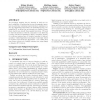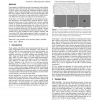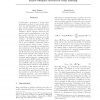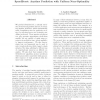CVPR
2012
IEEE
12 years 9 months ago
2012
IEEE
In this paper, we propose a bilevel sparse coding model for coupled feature spaces, where we aim to learn dictionaries for sparse modeling in both spaces while enforcing some desi...
SIGIR
2012
ACM
12 years 10 months ago
2012
ACM
As ever-larger training sets for learning to rank are created, scalability of learning has become increasingly important to achieving continuing improvements in ranking accuracy [...
106
click to vote
KDD
2012
ACM
12 years 10 months ago
2012
ACM
Multi-task learning (MTL) aims to improve the performance of multiple related tasks by exploiting the intrinsic relationships among them. Recently, multi-task feature learning alg...
102
click to vote
KDD
2012
ACM
12 years 10 months ago
2012
ACM
Multi-instance multi-label learning (MIML) is a framework for supervised classification where the objects to be classified are bags of instances associated with multiple labels....
KDD
2012
ACM
12 years 10 months ago
2012
ACM
Traditional co-clustering methods identify block structures from static data matrices. However, the data matrices in many applications are dynamic; that is, they evolve smoothly o...
106
click to vote
TOG
2012
12 years 10 months ago
2012
Point samples with different spectral noise properties (often defined using color names such as white, blue, green, and red) are important for many science and engineering discip...
JMLR
2012
12 years 10 months ago
2012
In recent years there has been a lot of interest in designing principled classification algorithms over multiple cues, based on the intuitive notion that using more features shou...
JMLR
2012
12 years 10 months ago
2012
In this paper, we propose a second order optimization method to learn models where both the dimensionality of the parameter space and the number of training samples is high. In ou...
JMLR
2012
12 years 10 months ago
2012
We develop a high dimensional nonparametric classification method named sparse additive machine (SAM), which can be viewed as a functional version of support vector machine (SVM)...
JMLR
2012
12 years 10 months ago
2012
We present SpeedBoost, a natural extension of functional gradient descent, for learning anytime predictors, which automatically trade computation time for predictive accuracy by s...







